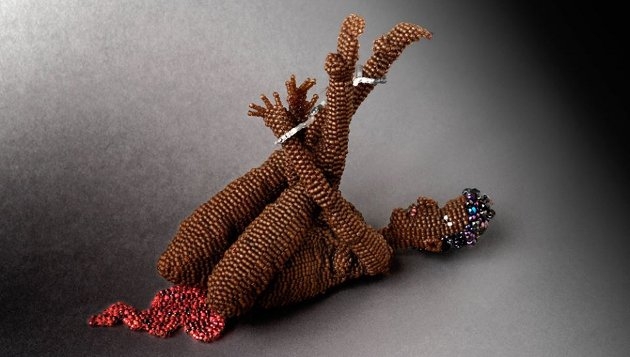Now if my sister Doris knows anything, it’s violence.
So when we both found ourselves in Johannesburg, we went to see the ‘Women and Violence’ exhibit in the local Art Gallery.
It was a bit difficult to find the art through the lengthy writing on the walls -by someone who was clearly not in favour of violence against women-, and the big pictures of Amnesty International, a peace NGO and an agricultural project from Sierra Leone. “I didn’t know this was a workshop”, Doris hissed at me. Oh boy. Ever since I mistakenly invited her to a Modern Parenthood Awareness lecture I know better than to take Doris to something educational.
To make things worse, there was bead work. Bead work occupies a special place among the things that make Doris angry. (They are many things, but we are patient with her because the guy she married had loose hands and she did suffer a lot before she finally got some local boys to help her chase him out and set his clothes and car on fire.)
“Beads?” Her high-pitched, argumentative voice made a union delegation –which was visiting the exhibit with rather dutiful faces, probably as part of a gender programme-, look up with concern. “Are you kidding me? They got us as slaves in exchange for beads and mirrors and here I am looking at beads again?”
I quickly showed her Jane Alexander, Yoko Ono, and Hung Liu. Except for Yoko Ono, ‘who is always undressing herself’, Doris liked them. But even these artists were framed by explanations of ‘things that every child knows’ like that many women are victims of violence and that something ought to be done about it. Doris started making notes to write to ‘all these ladies’ to tell them how their work was being drowned in ‘do-gooder nonsense’.
Doris also kept asking where ‘we’ were. Black people, she meant. She didn’t consider north Africans Amal Kenawy and Fatou Kande Senghor as really ‘us’, though she did appreciate their work. “The only black ladies I see are those agricultural and bead people. So we can’t do any art?” Doris has met Wangechi Mutu from Kenya who lives in New York, so she knows that there is at least one black African lady who does real art. Mutu’s work was supposed to be here too but somehow we could not find it. “She must have run a mile when they hung her next to beads”, said Doris.
Then I lost Doris for a bit, only to find her again in a remote room, staring at a print of a woman sitting on a park bench. “Senzeni Marasela -Comforter on a bench”, read the unusually short caption. “This is a woman who knows violence”, said Doris. “Look.” The woman actually bore a resemblance to Doris –the Doris who sits down, alone, after a day of struggle and anger, the empty Doris that Doris herself doesn’t want you to see. I had seen several other women like that, sitting outside, catching some sun in Joubert Park. “So they did get something right”, I said, relieved. Only to notice, as we left, that this room hadn’t been part of the Women and Violence exhibit at all.


